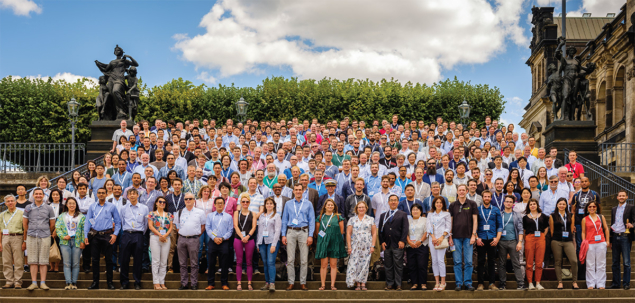
Accelerator experts from around the world met from 30 June – 5 July in Dresden’s historic city centre for six days of intense discussions on superconducting radio-frequency (SRF) science and technology. The Helmholtz-Zentrum Dresden-Rossendorf (HZDR) hosted the 19th conference in the biannual series, which demonstrated that SRF has matured to become the enabling technology for many applications. New SRF-based large-scale facilities throughout the world include the European XFEL in Germany, LCLS-II and FRIB in the US, ESS in Sweden, RAON in Korea, and SHINE in China.
The conference opened on Germany’s hottest day of the year with a “young scientists” session comprising 40 posters. The following week featured a programme packed with 67 invited oral presentations, more than 300 posters and an industrial exhibition. Keynote lecturer Thomas Tschentscher (European XFEL) discussed applications of high-repetition-rate SRF-based X-ray sources, while Andreas Maier (University of Hamburg) reviewed rapidly advancing laser-plasma accelerators, emphasising their complementarity with SRF-based systems.
Much excitement in the community was generated by new, fundamental insights into power dissipation in RF superconductors. A better understanding of the role of magnetic flux trapping and impurities for RF losses has pushed state-of-the-art niobium to near its theoretical limit. However, recent advances with Nb3Sn (CERN Courier July/August 2019 p9) have demonstrated performance levels commensurate with established niobium systems, but at a much higher operating temperature (≥ 4.2 K rather than ≤ 2 K). Such performance was unthinkable just a few years ago. Coupled with technological developments for tuners, digital control systems and cavity processing, turn-key high-field and continuous-wave operation at 4.2 K and above appears within reach. The potential benefit for both large-scale facilities as well as compact SRF-based accelerators in terms of cost and complexity is enormous.
The SRF conference traditionally plays an important role in attracting new, young researchers and engineers to the field, and provides them with a forum to present their results. In the three days leading up to the conference, HZDR hosted tutorials covering all aspects from superconductivity fundamentals to cryomodule design, which attracted 89 students and young scientists. During the conference, 18 young investigators were invited to give presentations. Bianca Giaccone (Fermilab) and Ryan Porter (Cornell University) received prizes for the best talks, alongside Guilherme Semione (DESY) for best poster.
The SRF conference rotates between Europe, Asia and the Americas. SRF 2021 will be hosted by Michigan State University/FRIB, while SRF 2023 moves on to Japan’s Riken Nishina Center.







